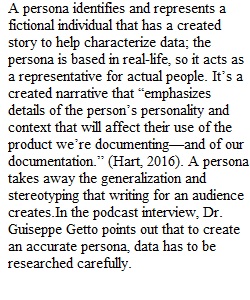


Q In this discussion topic, your response to this discussion is due by this week Friday at midnight Eastern Standard Time (EST). You are also asked to respond to at least one other student in the class on his or her response. Your response to your fellow student is due by this week Sunday at midnight Eastern Standard Time (EST). Your first writing assignment will be to write three personas. This discussion topic is designed to help you become familiar with what a persona is and what its role is in technical writing. Please access the following url and listen to the podcast, "Dr. Kirk St. Amant and Dr. Guiseppe Getto on User Personas and Intercultural Communication." 10-Minute Tech Comm - Dr. Kirk St. Amant and Dr. Guiseppe Getto on User Personas and Intercultural Communication on Stitcher Please answer the following questions. Your answers can be a couple of sentences or so. 1. What is a persona? What do personas represent? 2. How does a writer make a persona that is accurate, useful, and representative and that does not simply stereotype a population? 3. What is the difference between audience and persona? 4. Why is user behavior important for personas?
View Related Questions